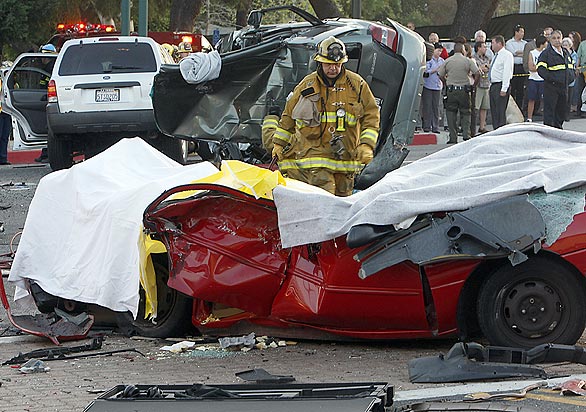NHTSA/NASA studied the software and failed to discern a flaw for SUA [Sudden Unintended Acceleration] that killed 89 people.

There is no indication that they studied the software from any of the vehicles that crashed.

There's more to this!

U.S. Department of Transportation Releases Results from NHTSA-NASA Study of Unintended Acceleration in Toyota Vehicles
DOT 16-11
Tuesday, February 8, 2011
Contact: Olivia Alair
Tel: (202) 366-4570
WASHINGTON, DC -- The U.S. Department of Transportation released results from an unprecedented ten-month study of potential electronic causes of unintended acceleration in Toyota vehicles. The National Highway Traffic Safety Administration (NHTSA) launched the study last spring at the request of Congress, and enlisted NASA engineers with expertise in areas such as computer controlled electronic systems, electromagnetic interference and software integrity to conduct new research into whether electronic systems or electromagnetic interference played a role in incidents of unintended acceleration.
NASA engineers found no electronic flaws in Toyota vehicles capable of producing the large throttle openings required to create dangerous high-speed unintended acceleration incidents. The two mechanical safety defects identified by NHTSA more than a year ago – “sticking” accelerator pedals and a design flaw that enabled accelerator pedals to become trapped by floor mats – remain the only known causes for these kinds of unsafe unintended acceleration incidents. Toyota has recalled nearly 8 million vehicles in the United States for these two defects.
U.S. Transportation Secretary Ray LaHood said, “We enlisted the best and brightest engineers to study Toyota’s electronics systems, and the verdict is in. There is no electronic-based cause for unintended high-speed acceleration in Toyotas."
In conducting their report, NASA engineers evaluated the electronic circuitry in Toyota vehicles and analyzed more than 280,000 lines of software code for any potential flaws that could initiate an unintended acceleration incident. At the Goddard Space Flight Center in Maryland, NASA hardware and systems engineers rigorously examined and tested mechanical components of Toyota vehicles that could result in an unwanted throttle opening. At a special facility in Michigan, NHTSA and NASA engineers bombarded vehicles with electromagnetic radiation to study whether such radiation could cause malfunctions resulting in unintended acceleration. NHTSA engineers and researchers also tested Toyota vehicles at NHTSA’s Vehicle Research and Test Center in East Liberty, Ohio to determine whether there were any additional mechanical causes for unintended acceleration and whether any of the test scenarios developed during the NHTSA-NASA investigation could actually occur in real-world conditions.
"NASA found no evidence that a malfunction in electronics caused large unintended accelerations," said Michael Kirsch, Principal Engineer at the NASA Engineering and Safety Center (NESC).
While NASA and NHTSA have identified no electronic cause of dangerous unintended acceleration incidents in Toyota vehicles or any new mechanical causes beyond sticking pedals and accelerator pedal entrapment, NHTSA is considering taking several new actions as the result of today’s findings, including:
- Propose rules, by the end of 2011, to require brake override systems, to standardize operation of keyless ignition systems, and to require the installation of event data recorders in all passenger vehicles;
- Begin broad research on the reliability and security of electronic control systems;
- Research the placement and design of accelerator and brake pedals, as well as driver usage of pedals, to determine whether design and placement can be improved to reduce pedal misapplication.
“While today marks the end of our study with NASA, our work to protect millions of American drivers continues,” said NHTSA Administrator David Strickland. “The record number of voluntary recalls initiated by automakers last year is also very good news, and shows that we can work cooperatively with industry to protect consumers."
Based on objective event data recorder (EDR) readings and crash investigations conducted as part of NHTSA’s report, NHTSA is researching whether better placement and design of accelerator and brake pedals can reduce pedal misapplication, which occurs in vehicles across the industry. NHTSA’s forthcoming rulemaking to require brake override systems in all passenger vehicles will further help ensure that braking can take precedence over the accelerator pedal in emergency situations. The ongoing National Academy of Sciences study, which will examine unintended acceleration and electronic vehicle controls across the entire automotive industry, will also make recommendations to NHTSA. The NAS study was launched in spring 2010 alongside the NHTSA-NASA investigation and will be finalized later in 2011.
In 2009 and 2010, Toyota recalled nearly eight million vehicles as part of the sticky pedal and pedal entrapment recalls. Toyota also paid $48.8 million in civil penalties as the result of NHTSA investigations into the timeliness of several safety recalls last year. Across the industry, automakers voluntarily initiated a record number of safety recalls in 2010.
- NASA Report Executive Summary and Findings
- NASA Complete Report
- NHTSA Report Executive Summary and Findings
- NHTSA Complete Report
- Additional Information and Supporting Documentation
Toyota has recalled nearly eight million vehicles in the United States for two mechanical safety defects that can cause unintended acceleration: ‘sticking’ accelerator pedals and a design flaw that can cause accelerator pedals to become trapped by floor mats. When NHTSA first identified the two defects more than a year ago, the agency pushed Toyota to conduct recalls quickly. Toyota later paid nearly $33 million in civil penalties as the result of investigations into whether the company notified NHTSA in a timely manner about these defects.
During Congressional hearings on the Toyota recalls in February 2010, Members of Congress asked NHTSA to study whether electronic or software problems in Toyota vehicles could be to blame for unintended acceleration. At Congress’ request, NHTSA simultaneously launched two studies: one designed to evaluate possible electronic causes for unintended acceleration in Toyotas, and a broader effort to look at unintended acceleration across the automotive industry.
In March 2010, NHTSA enlisted top NASA engineers and experts in areas such as electromagnetic compatibility to study whether electronic flaws can cause unintended acceleration. In its final report, NASA engineers found no evidence of an electronic defect in Toyota vehicles capable of producing dangerous, high-speed unintended acceleration incidents. The two mechanical safety defects originally identified by NHTSA remain the only known causes of dangerous unintended acceleration incidents.
Nevertheless, NHTSA has announced several new actions it may take as a result of their work with NASA to address the safety of vehicle electronics systems. NHTSA will consider rules to require brake override systems, standardize operation of keyless ignition systems, and require the installation of event data recorders in all passenger vehicles. NHTSA will conduct broad research on the reliability of electronic throttle control systems across the vehicle fleet. The agency will also initiate new research on driver behavior and the placement and design of floor pedals in an effort to identify strategies that can reduce pedal misapplication.
The second study launched by U.S. DOT in March 2010 remains under way. The Department has enlisted the prestigious National Academy of Sciences (NAS) to undertake a broad review of unintended acceleration and electronic vehicle controls across the automotive industry. An independent panel of scientific experts at NAS is currently working to identify possible sources of unintended acceleration, including electronic vehicle controls and human error. Later in 2011, the panel will make recommendations to NHTSA on how its rulemaking, research, and defect investigation activities can help ensure the safety of electronic control systems in motor vehicles.
Timeline of Major Events
- March 29, 2007: NHTSA opens a preliminary investigation into pedal entrapment on MY’07 Lexus ES350 models based on five consumer complaints alleging three crashes and seven injuries. The all weather floor mat is identified as the possible cause of these incidents.
- July 26, 2007: A fatal crash occurs in San Jose, CA involving a ‘07 Camry in which the driver suffers serious injuries and the driver of the struck vehicle is killed. The incident also appears to have been caused by a pedal trapped by an all weather floor mat.
- September 13, 2007: After determining the fatal San Jose crash was caused by floor mat entrapment, NHTSA tells Toyota a recall is necessary.
- September 26, 2007: Toyota recalls 55,000 floor mats in ’07 and ‘08 Camrys and ES350s.
- August 28, 2009: A fatal crash occurs in Santee, CA, involving a loaner ’09 ES350. The vehicle is found to have an all weather floor mat from another Lexus vehicle. Investigators find that the vehicle’s previous driver had reported an entrapment incident to the dealership.
- September 25, 2009: NHTSA meets with Toyota and tells the company that the floor mat recall is insufficient and the agency expects a recall for the defect in pedal design. Three days later, Toyota tells NHTSA the company will recall the gas pedals.
- October 5, 2009: Toyota recalls 3.8 million vehicles for pedal entrapment by floor mat and sends an interim letter to consumers telling them to remove floor mats. The defect remedy involves gas pedal reconfiguration, floor pan/carpeting revisions, and ‘brake pedal override’ software for vehicles with keyless ignition.
- December 15, 2009: NHTSA officials meet with Toyota executives in Japan to explain NHTSA’s defect recall process and underscore Toyota’s obligations under U.S. law to find and report defects promptly. Toyota commits to making improvements.
- January 16, 2010: Toyota informs NHTSA that certain CTS-brand pedals may have a dangerous ‘sticking’ defect. NHTSA calls an in-person meeting on January 19.
- January 19, 2010: At the meeting, Toyota provides field reports on sticky pedal incidents, and NHTSA tells Toyota the agency expects prompt action. Toyota informs NHTSA several hours later that the company will issue a recall.
- January 21, 2010: Toyota recalls 2.3 million vehicles for the sticky pedal defect.
- January 27, 2010: At NHTSA’s urging, Toyota expands its pedal entrapment recall to cover an additional 1.1 million vehicles.
- February 16, 2010: NHTSA launches an official probe into the timeliness and scope of the pedal entrapment and sticky pedal Toyota recalls.
- March 30, 2010: At the request of Congress, the U.S. DOT announces two studies into unintended acceleration. One looks at possible electronics causes for unintended acceleration in Toyotas; the other examines unintended acceleration and the safety of vehicle electronics across the automotive industry.
- April 5, 2010: NHTSA demands the maximum, $16.375 million, civil penalty on Toyota for its failure to notify the agency of the sticky pedal defect for more than four months after discovering it. Auto manufacturers are legally obligated to notify NHTSA within five business days of determining that a safety defect exists. Toyota pays the full fine on April 19.
- December 20, 2010: Toyota agrees to pay the maximum $16.375 million civil penalty as the result of another NHTSA investigation into whether their recall of 5.5 million vehicles for pedal entrapment was conducted in a timely manner.
http://www.autosafety.org/us-department-transportation-releases-results-nhtsa-nasa-study-unintended-acceleration-toyota-vehicl
No comments:
Post a Comment